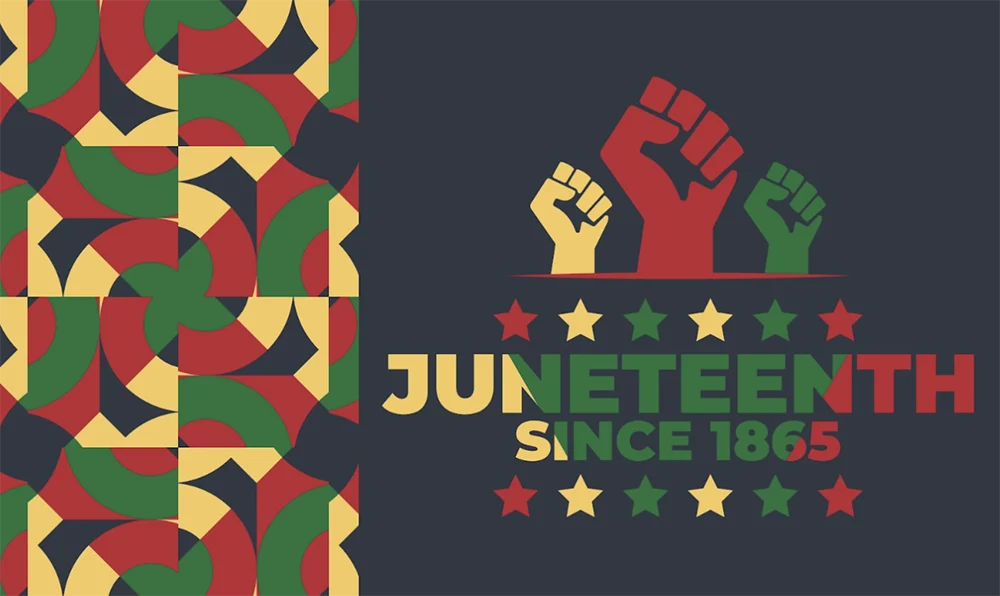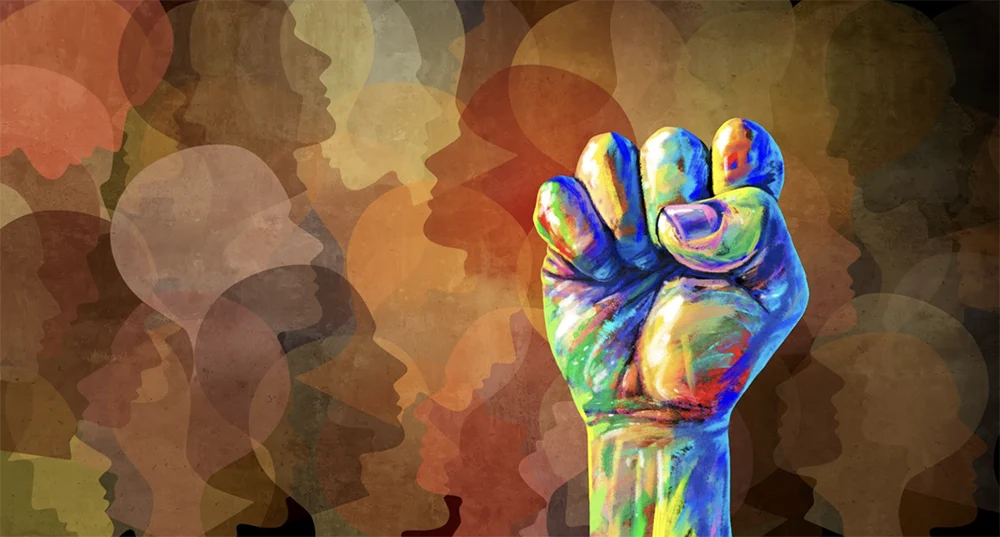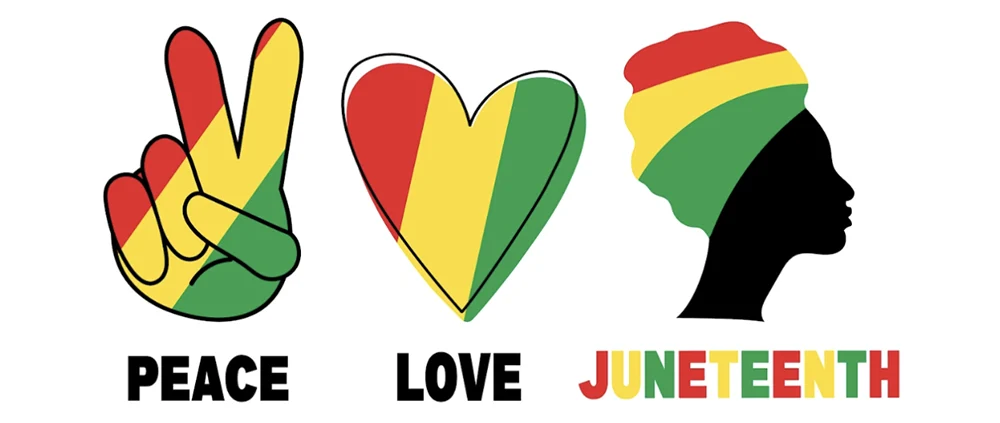AMERICA'S SECOND INDEPENDENCE DAY
Juneteenth
Introduction | Background Knowledge | Activities | Extensions | Standards

Introduction
June 19, 1865. Enslaved people in Galveston, Texas, woke up with no idea that freedom was coming to them that day.

Background Knowledge
On January 1, 1863, the Emancipation Proclamation went into effect and freed all of the enslaved people in the “rebellious states.” While it was not a perfect solution and did not end slavery immediately, freedom expanded with every Union victory in the South.
When Robert E. Lee surrendered on April 9, 1865, after four years of war, news that the war was over began to spread across the country. Many enslavers knew about the Emancipation Proclamation and the war's end, but freedom was only enforced once the Union Army took control of the area. As the Union Army moved West, more enslaved people learned that they were free.
Union General Gordon Granger and his troops arrived in Galveston, Texas, on June 19, 1865. The General issued General Order No. 3, which stated: “The people of Texas are informed that, in accordance with a proclamation from the Executive of the United States, all slaves are free. This involves an absolute equality of personal rights and rights of property between former masters and slaves, and the connection heretofore existing between them becomes that between employer and hired labor.” Although the General Orders encouraged them to stay with their former captors and work for a wage, people left Texas to try to locate family members and set up their new lives. Slavery was officially abolished when the Thirteenth Amendment was ratified in December 1865. Once freedom for all men, regardless of race, was made the law of the land, the free people had true cause to celebrate.
Juneteenth (short for June Nineteenth) was born from General Orders 3. The date has been known by several names, including Freedom Day, Jubilee Day, Cel-Liberation Day, Second Independence Day, and Emancipation Day. The first celebration was held in Texas in June 1866. Texas freedmen organized a celebration of freedom. They called it Jubilee Day. This celebration would become an annual event. In 1872, four former enslaved men purchased 10 acres of land in Houston, Texas. This land, now known as Emancipation Park, was to be a permanent place to celebrate freedom each year.
Celebrations for Juneteenth dwindled in the early 1900s. Jim Crow laws made life difficult for African Americans. The Great Depression devastated the country, and people left rural areas for city work. It was challenging to find time away from work to celebrate. Celebrations were revived during the Civil Rights Movement (1954 - 1968). Civil Rights leaders like Dr. Martin Luther King intentionally planned the Poor People's March to coincide with Juneteenth. In 1980, Texas made the day a state holiday, and neighboring states began to follow. Juneteenth became a federal holiday in 2021.
Juneteenth celebrations take many forms. Traditional celebrations include parades, rodeos, and races. More recently, a Miss Juneteenth pageant may culminate in the national contest. The first national winner was crowned in 2020. People also celebrate with food, joining together in a barbecue, as early as 1866 when “a big barbecue dinner was spread for the multitude.” Other traditional foods include watermelon, red foods, and Big Red soda, known as “red drink.” The color red is symbolic of power, sacrifice, and transformation.
A final hallmark of Juneteenth focuses on education. Americans cannot talk about the significance of Juneteenth without having honest and open conversations about slavery in the United States. The poet Maya Angelou said, “When you know better, you do better.” By confronting the past and having hard conversations, teachers and students can broaden their understanding and do better for this country.

ACTIVITIES
-
Read from this selected list of fiction books:
-
Juneteenth Jamboree by Carole Boston Weatherford (ISBN 978-1880000182) - Cassie and her family move to Texas and learn about Juneteenth for the first time.
- Extend learning with this learning guide.
- Juneteenth for Maize by Floyd Cooper (ISBN 978-1479558209) - Maize reflects on her ancestors' history as she prepares for Juneteenth celebrations.
- The Night Before Freedom by Glenda Armand (ISBN 978-0593567463) - David and his family gather at his grandmother's house for the annual retelling of the Juneteenth story.
- A Flag for Juneteenth by Kim Taylor (ISBN 978-0823452248) - Huldah and her family are enslaved on a plantation in Texas. When the news of freedom comes on Juneteenth, she and her community gather to create a freedom flag.
- Freedom's Gifts by Valerie Wesley (ISBN 978-0689802690) - June and her cousin, Lilly, learn about the significance of Juneteenth from their Great-great-aunt Marshall.
-
Juneteenth Jamboree by Carole Boston Weatherford (ISBN 978-1880000182) - Cassie and her family move to Texas and learn about Juneteenth for the first time.
-
Read from this selected list of nonfiction books:
- The History of Juneteenth by Arlisha Norwood (ISBN 978-1685394417) - A nonfiction introduction to Juneteenth.
- Freedom Rings: A Children's Book about Juneteenth by Sharday Moser (ISBN 978-1735789026) - A nonfiction introduction to Juneteenth
- Opal Lee and What It Means to Be Free: The True Story of the Grandmother of Juneteenth by Alice Faye Duncan (ISBN 978-1400231256) - Learn more about Opal Lee, a community activist who marched on Washington to make Juneteenth a national holiday.
- Juneteenth: A Children's Story by Opal Lee (ISBN 979-8985458800) - The ‘Grandmother of Juneteenth' writes a book explaining the holiday for children.
- What is Juneteenth? by Kirsti Jewel (ISBN 978-0593384695) - A nonfiction introduction to Juneteenth.
- Booklists
- Explore the National Museum of African American History's Juneteenth Toolkit, which includes information and conversation questions for younger children.
- Examine primary sources from the Glider Lehrman Institute. Resources are available after registering for a free account. Use an artificial intelligence (AI) tool such as MagicSchool.ai (TeachersFirst review) to create leveled text and summaries of documents written for students in your grade level. For example, copy the transcript for the Emancipation Proclamation into MagicSchool's text leveler tool, select 5th grade, and receive this summary of the document written for fifth-grade student reading levels. You need to create a MagicSchool.ai account to view the summary. Additional tools to use on MagicSchool to enhance learning include a YouTube question generator, a Choice Board generator, and a generator that creates multiple explanations of complex concepts.
-
TeachersFirst has tagged resources about Juneteenth.
- Curate your saved Juneteenth resources using Wakelet (TeachersFirst review). Find many examples and collections by searching for Juneteenth on Wakelet, then make a copy of any collection to add to your Wakelet account.
- Curate resources using Symbaloo EDU (TeachersFirst review) for easy access for you and your students.
- Create a learning path using Symbaloo Learning Paths. Learn more about Learning Paths from this archive of an OK2Ask professional learning session and this TeachersFirst blog post.
- Listen to this podcast from Black History for White People. Search for additional podcasts to share with students and add them as a resource for students on Padlet (TeachersFirst review) along with your other Juneteenth resources. Visit this Juneteenth Padlet to view an example.
- Compare and contrast July 4th and Juneteenth with this activity from Read, Write, Think.
- Watch this video about Juneteenth and use Twee (TeachersFirst review) to enhance learning. Visit the Watch and Listen category on Twee to find tools to convert audio and video to text, generate questions from videos, create a summarizing activity from your video, and produce warm-up questions to use before watching the video.

EXTENSIONS
-
What is Freedom?
- Read this article from Time magazine about the meanings of Freedom. Create a class Padlet (TeachersFirst review) about what freedom means.
Information Campaign
- Create a poster using Canva (TeachersFirst review) to share information about Juneteenth. Learn more about using Canva in the classroom from this OK2Ask Webinar.
- Use this template from Genially (TeachersFirst review) as an example to introduce Juneteenth to students, then ask students to use the template as inspiration for creating an informational presentation about Juneteenth.

CORRELATION TO STANDARDS
- AASL National School Library Standards
- Inquire Shared Foundation, Think Domain - Learners display curiosity and initiative by: 1. Formulating questions about a personal interest or a curricular topic. 2. Recalling prior and background knowledge as context for new meaning.
- Inquire Shared Foundation, Share Domain - Learners adapt, communicate, and exchange learning products with others in a cycle that includes: 1. Interacting with content presented by others. 2. Providing constructive feedback. 3. Acting on feedback to improve. 4. Sharing products with an authentic audience.
- Include Shared Foundation, Share Domain - Learners exhibit empathy with and tolerance for diverse ideas by: 1. Engaging in informed conversation and active debate. 2. Contributing to discussions in which multiple viewpoints on a topic are expressed.
- Include Shared Foundation, Grow Domain - Learners demonstrate empathy and equity in knowledge building within the global learning community by: 1. Seeking interactions with a range of learners.
- Collaborate Shared Foundation, Think Domain - Learners identify collaborative opportunities by: 1. Demonstrating their desire to broaden and deepen understandings. 2. Developing new understandings through engagement in a learning group. 3. Deciding to solve problems informed by group interaction.
- Collaborate Shared Foundation, Create Domain - Learners participate in personal, social, and intellectual networks by: 1. Using a variety of communication tools and resources. 2. Establishing connections with other learners to build on their own prior knowledge and create new knowledge.
- Collaborate Shared Foundation, Grow Domain - Learners actively participate with others in learning situations by: 2. Recognizing learning as a social responsibility.
- Explore Shared Foundation, Think Domain - Learners develop and satisfy personal curiosity by: 1. Reading widely and deeply in multiple formats and writing and creating for a variety of purposes.
- Explore Shared Foundation, Create Domain - Learners construct new knowledge by: 1. Problem solving through cycles of design, implementation, and reflection.
- Explore Shared Foundation, Share Domain - Learners engage with the learning community by: 3. Collaboratively identifying innovative solutions to a challenge or problem.
- Explore Shared Foundation, Grow Domain - Learners develop through experience and reflection by: 1. Iteratively responding to challenges. 2. Recognizing capabilities and skills that can be developed, improved, and expanded. 3. Open-mindedly accepting feedback for positive and constructive growth.
-
ISTE Standards for Students
- Empowered Learner - 1b. Students build networks and customize their learning environments in ways that support the learning process. 1c. Students use technology to seek feedback that informs and improves their practice and to demonstrate their learning in a variety of ways.
- Knowledge Constructor - 3d. Students build knowledge by actively exploring real-world issues and problems, developing ideas and theories, and pursuing answers and solutions.
- Innovative Designer - 4d. Students exhibit a tolerance for ambiguity, perseverance, and the capacity to work with open-ended problems.
- Global Collaborator - 7c. Students contribute constructively to project teams, assuming various roles and responsibilities to work effectively toward a common goal.
